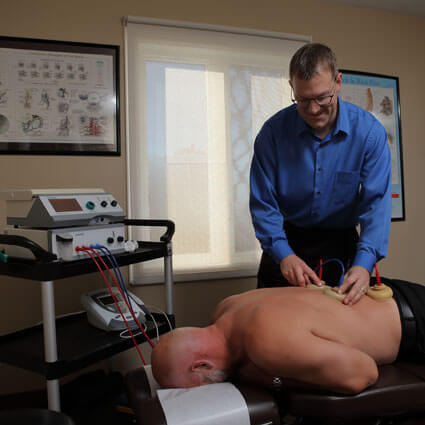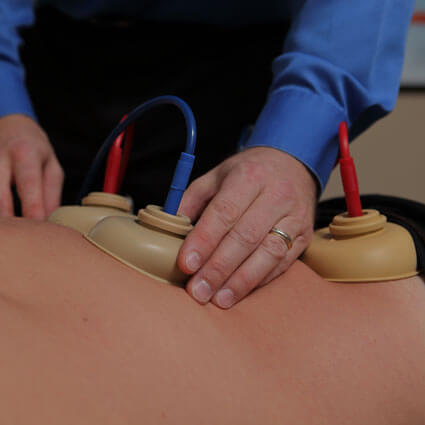Soft Tissue Therapy
Alta Vista Chiropractic & Massage Clinic offers soft tissue therapy as a part of our integrative care plans. Soft tissue therapy is a way to address restricted range of motion in the joints. To do this, we use a combination of our preferred techniques to break up scarring or adhesions that have occurred.
Doing this comes with a variety of potential health benefits, including pain relief and increased mobility.
What We Offer
All soft tissue therapy begins softly. Throughout your time with us, we will gently take you through various levels of passes to determine your current range of motion. We will gradually increase the strength of the passes to see how your body responds. With that information, we can identify the exact locations of the scarring and adhesions that are limiting your ability to move. Once we have a better idea of what we need to address, we can begin soft tissue therapy that suits your needs.
We rely on three main soft tissue techniques to help our patients move more efficiently. These methods of care include Active Release Technique® (ART®), The Graston Technique®, and Myofascial Release Technique.
Active Release Technique® (ART) is a non-invasive, manual soft tissue technique that uses the examiner’s hands to diagnose and address the underlying causes of various disorders that result in symptoms of numbness, tingling, burning and aching. The main purpose of ART® is to re-establish motion between soft tissue (muscles, tendons, ligaments, blood vessels, fascia and nerves) by decreasing fibrous adhesions (scar tissue between muscles, nerves and other connective tissue).
Most conditions respond to ART® therapy soon after treatment begins. Many times, significant improvement is attained on the first visit. This is incredible when you consider that most people with this type of injury can go an entire lifetime without relief.
The Graston Technique®, originally developed by athletes, is changing the way clinicians – including physical and occupational therapists, hand therapists, chiropractors and athletic trainers – and patients view care of acute and chronic soft tissue injuries.
Graston Technique® is an innovative, patented form of instrument-assisted soft tissue mobilization that enables clinicians to effectively break down scar tissue and fascial restrictions. The technique utilizes specially-designed stainless-steel instruments to specifically detect and effectively treat areas exhibiting soft tissue fibrosis or chronic inflammation.
Myofascial Release is a form of bodywork that is manipulative in nature and seeks to rebalance the body by releasing tension in the fascia. Long, stretching strokes are utilized to release muscular tension. It is a manual therapy technique that is utilized to help relieve pain and tension that is due to injury or stress.
M.F.R. involves releasing and unwinding the fascia (connective tissue) that surrounds each muscle and interconnects all of the other internal parts of the body. This tissue layer, which connects every muscle, tendon, ligament, bone, and organ in our bodies, can store memories of physical trauma. Releasing these restrictions allows us to discharge recurring emotional as well as physical pain. Sessions can include craniosacral work, stretching techniques, and deep touch.
Our bodies contain special protein structures called connective tissue, also known as fascia. This substance connects each part of our bodies to other parts and the whole, very much like a flexible skeleton. When this tissue is healthy, it is smooth and slippery, allowing the muscles, nerves, blood vessels or organs to move freely and function properly.
Imagine a piece of scotch tape. The smooth side is healthy fascia and the sticky side is scar tissue or unhealthy fascia. You rub the tape along your skin with both sides to “feel” what an adhesion is like. The drag that you feel, the “pulling” sensation, is the adhesion. These adhesions attach to muscles decreasing their ability to work properly. Adhesions on the nerves lend themselves to many abnormal sensations like numbness, tingling or pain.
Adhesions can decrease the soft tissue’s own blood, lymph, and nerve supplies. When this occurs within muscle alone, it is usually the cause of the common trigger point and is often associated with chronic muscle pain.
Adhesions and scar tissue are a result of when soft tissue structures are exposed to damaging forces. These forces usually come about in one of three different ways: a sudden or acute injury, a cumulative or chronic injury, or a pressure injury from external forces like poor posture.
These injuries cause restrictions of movement, blood flow, lymph flow, and nerve conduction. The adhesions may develop between the fascia (the covering of muscles), the muscles themselves, muscles and bones, muscles and nerves, tendons and joints, and many other combinations involving the soft tissues of the neuromusculoskeletal system.
Schedule Your Appointment
Does soft tissue therapy sound like something that might benefit you? You may be right.
Reach out to us for more information or to schedule your appointment! We look forward to hearing from you.
CONTACT US »




